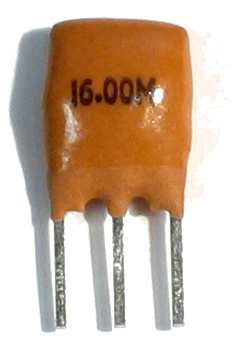 A 16 MHz ceramic resonator | |
| Type | Electromechanical |
|---|---|
| Working principle | Piezoelectricity, Resonance |
A ceramic resonator is an electronic component consisting of a piece of a piezoelectric ceramic material with two or more metal electrodes attached. When connected in an electronic oscillator circuit, resonant mechanical vibrations in the device generate an oscillating signal of a specific frequency. Like the similar quartz crystal, they are used in oscillators for purposes such as generating the clock signal used to control timing in computers and other digital logic devices, or generating the carrier signal in analog radio transmitters and receivers.
Ceramic resonators are made of high-stability piezoelectric ceramics, generally lead zirconate titanate (PZT) which functions as a mechanical resonator. In operation, mechanical vibrations induce an oscillating voltage in the attached electrodes due to the piezoelectricity of the material. The thickness of the ceramic substrate determines the resonant frequency of the device.